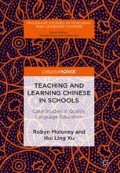Abstract
This chapter features the application of digital technologies from our case study secondary teachers’ practice, to illustrate the changes occurring in the learning and teaching of Chinese. New technologies can greatly facilitate students’ own initiative, providing them with personalised learning opportunities to make choices, to create tasks, to use games, to interact with others, to explore media, and to engage in language and culture simulations. The chapter details the specific affordance of technologies in the various areas of learning including acquisition of characters, speaking, writing, vocabulary and grammar, independent learning, learning and teaching management, and differentiated learning. The chapter summarises the benefits to students and teachers, in supporting motivated quality teaching and learning of Chinese.
Access this chapter
Tax calculation will be finalised at checkout
Purchases are for personal use only
References
Beetham, H., & Sharpe, R. (2013). Rethinking pedagogy for a digital age: Designing for 21st century learning. Abingdon: Routledge.
Blake, R. J. (2013). Brave new digital classroom: Technology and foreign language learning. Washington, DC: Georgetown University Press.
Chang, K. E., Lan, Y. J., Chang, C. M., & Sung, Y. T. (2010). Mobile-device-supported strategy for Chinese reading comprehension. Innovations in Education and Teaching International, 47(1), 69–84.
Chen, H. Y., & Liu, K. Y. (2008). Web-based synchronized multimedia lecture system design for teaching/learning Chinese as second language. Computer & Education, 50(3), 693–702.
Evans, M. (Ed.). (2009). Foreign language learning with digital technology. London and New York: Continuum International Publishing Group.
Fredlein, S., & Fredlein, P. (2011). Ni Hao 2: Chinese language course, elementary level. Brisbane: ChinaSoft.
Grant, S., & Huang, H. (2010). The integration of an online 3D virtual learning environment into formal classroom-based undergraduate Chinese language and culture curriculum. Journal of Technology and Chinese Language Teaching, 1(1), 2–13.
Henderson, M., Huang, H., & Grant, S. (2012). The impact of Chinese language lessons in a virtual world on university students’ self-efficacy beliefs. Australasian Journal of Educational Technology, 28(3), 400–419. Retrieved from http://www.ascilite.org.au/ajet/ajet28/hender son.html
Hawkes, R. (2009). Digital technology as a tool for active learning in MFL: Engaging language learners in and beyond the secondary classroom. In M. Evans (Ed.), Foreign language learning with digital technology. New York: Continuum International Publishing Group.
Kramsch, C. (2013). Foreword. In R. J. Blake (Ed.), Brave new digital classroom: Technology and foreign language learning (2nd ed., p. xii). New York: Georgetown University Press.
Lin, C. Y., Huang, C. K., & Chen, C. H. (2014). Barriers to the adoption of ICT in teaching Chinese as a foreign language in US universities. ReCall. 26(1), 100–116. European Association for Computer Assisted Language Learning. doi: https://doi.org/10.1017/S0958344013000268
Lin, M. C., & Wang, P. Y. (2008). A knowledge management system for Chinese language arts teachers. British Journal of Educational Technology, 39(5), 935–943.
McLaren, A. E., & Bettinson, M. (2015). Digital tools for Chinese character acquisition and their impact on student motivation. In R. Moloney & H. L. Xu (Eds.), Exploring innovative pedagogy in the teaching and learning of Chinese as a foreign language (pp. 235–252). Singapore: Springer.
Mitchell, I. (2009). The potential of the internet as a language-learning tool. In M. Evans (Ed.), Foreign language learning with digital technology (pp. 32–59). London and New York: Continuum International Publishing Group.
Mullamaa, K. (2010). ICT in language learning—Benefits and methodological implications. International Education Studies, 3(1), 38.
Orton, J., & Cui, X. (2015). Principles and innovation design: CLIL units in Chinese. In R. Moloney & H. L. Xu (Eds.), Exploring innovative pedagogy in the teaching and learning of Chinese as a foreign language (pp. 39–60). Singapore: Springer.
Pasfield-Neofitou, S. E., Grant, S., & Huang, H. (2015). Task-based Chinese as a Foreign Language (CFL) in second life for beginner learners and educators. In R. Moloney & H. L. Xu (Eds.), Exporting innovative pedagogy in the teaching and learning of Chinese (pp. 16–22). Singapore: Springer.
Scarino, A., & Liddicoat, A. J. (2009). Teaching and learning languages: A guide. Carlton: Commonwealth of Australia.
Wang, Y. (2015). Innovative learning design for online-language learning: A systems design framework. In R. Moloney & H. L. Xu (Eds.), Exporting innovative pedagogy in the teaching and learning of Chinese (pp. 253–271). Singapore: Springer.
Xu, H. L., & Moloney, R. (2011a). Perceptions of IWB pedagogy in the teaching of Chinese. Australasian Journal of Educational Technology, 27(2), 307–325.
Xu, H. L., & Moloney, R. (2011b). “It makes the whole learning experience better”: Student feedback on the use of the interactive whiteboard in learning Chinese at tertiary level. Asian Social Science, 7(11), 20.
Zhao, Y. (2012). Digital resources and their use in Chinese language classrooms and beyond. Melbourne: The University of Melbourne.
Author information
Authors and Affiliations
Rights and permissions
Copyright information
© 2018 The Author(s)
About this chapter
Cite this chapter
Moloney, R., Xu, H.L. (2018). The Use of Digital Technologies in Quality Teaching of Chinese. In: Teaching and Learning Chinese in Schools. Palgrave Studies in Teaching and Learning Chinese. Palgrave Pivot, Cham. https://doi.org/10.1007/978-3-319-89372-3_4
Download citation
DOI: https://doi.org/10.1007/978-3-319-89372-3_4
Published:
Publisher Name: Palgrave Pivot, Cham
Print ISBN: 978-3-319-89371-6
Online ISBN: 978-3-319-89372-3
eBook Packages: Social SciencesSocial Sciences (R0)

